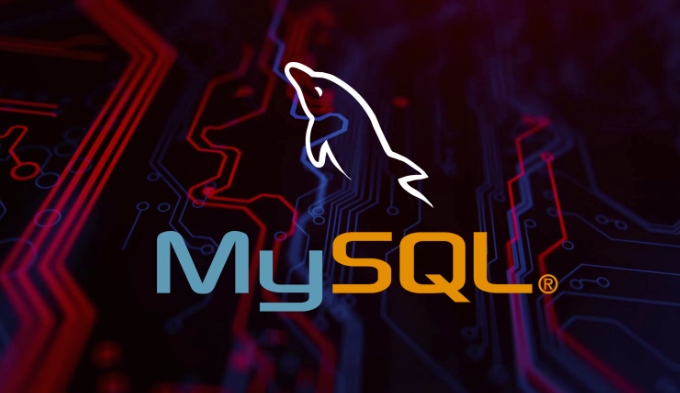The actual function of MySQL trigger is to automatically perform additional operations when data changes, such as generating default settings, recording logs, data backup, etc. For example, when updating the order status, the old status will be automatically recorded in the log table. The basic types of triggers are divided into BEFORE triggers (for verification or preprocessing) and AFTER triggers (for logging or subsequent processing). Each type can correspond to three operations: INSERT, UPDATE, and DELETE, and a total of 6 combinations are formed, such as BEFORE INSERT, AFTER UPDATE, etc. The syntax for creating triggers includes defining the name, point in time, operation type, association table and specific SQL statements, such as automatically writing statistics tables when inserting new employees. When using triggers, you need to pay attention to debugging difficulties, performance impact, high permission requirements, and complex migration and maintenance. Use them reasonably to improve efficiency, and excessive dependence may lead to maintenance problems.

A MySQL Trigger is a database object associated with a table that automatically executes a predefined piece of SQL code when a specified data operation event (such as INSERT, UPDATE, or DELETE) occurs. Simply put, a trigger is like a "listener". When a certain table changes, it will automatically "response".

What is the actual role of MySQL triggers?
The most common use of triggers is to automatically perform some additional operations when data changes. For example:
- Automatically generate default settings when inserting new users
- Logging the log when modifying the order status
- Make a backup of data before deleting records
These operations do not require manual calls, and will be automatically run as long as the trigger conditions are met.

For example: you have an orders table and an order_logs table. Whenever someone updates the order status, you can automatically record the old status to the log table through the trigger.
What are the basic types of MySQL triggers?
Triggers are mainly divided into two categories, which are distinguished according to the time points they execute before and after data operations:

- BEFORE trigger : Execute before actual operations (such as INSERT, UPDATE, DELETE), suitable for some verification or preprocessing.
- AFTER Trigger : Executes after the operation is completed and is suitable for logging or subsequent processing.
In addition, each trigger can also correspond to one of the following three operations:
- INSERT (insert new record)
- UPDATE (update records)
- DELETE (Delete record)
Therefore, there are 6 possible trigger combinations, such as BEFORE INSERT, AFTER UPDATE, etc.
How to create a simple trigger?
The basic syntax for creating a trigger is as follows:
CREATE TRIGGER trigger_name
BEFORE/AFTER INSERT/UPDATE/DELETE ON table_name
FOR EACH ROW
BEGIN
-- SQL statement to be executed END;For example: When you insert a new employee record, the employee's name is automatically written to another statistics table.
CREATE TRIGGER after_employee_insert
AFTER INSERT ON employees
FOR EACH ROW
BEGIN
INSERT INTO employee_log (name, action, created_at)
VALUES (NEW.name, 'insert', NOW());
END; NEW.name is used here to reference the new record field value that has just been inserted.
Note: Be careful to avoid loop triggering when using triggers. For example, A triggers B, and B triggers A in turn, which will lead to a dead loop.
What should I pay attention to when using triggers?
Although triggers are powerful, there are some limitations and potential issues to be paid attention to when using:
- Debugging difficulty : Triggers are implicitly executed, and their behavior is not easy to detect, so it is more troublesome to troubleshoot errors.
- Performance Impact : If the internal logic of the trigger is complex or executed frequently, it may slow down the overall performance of the database.
- High permission requirements : Creating and managing triggers usually requires high database permissions.
- Complex migration and maintenance : Triggers are not part of the table structure and are easily ignored and are easily missed in database migration or version control.
If you just want to implement simple automation tasks, triggers are a good choice; but if the logic is too complicated, it is recommended to consider using program code instead.
Basically that's it. Triggers are a very practical but easily abused function. Rational use can improve efficiency, and excessive dependence may also bring maintenance problems.
The above is the detailed content of what is a mysql trigger. For more information, please follow other related articles on the PHP Chinese website!

Hot AI Tools

Undress AI Tool
Undress images for free

Undresser.AI Undress
AI-powered app for creating realistic nude photos

AI Clothes Remover
Online AI tool for removing clothes from photos.

Clothoff.io
AI clothes remover

Video Face Swap
Swap faces in any video effortlessly with our completely free AI face swap tool!

Hot Article

Hot Tools

Notepad++7.3.1
Easy-to-use and free code editor

SublimeText3 Chinese version
Chinese version, very easy to use

Zend Studio 13.0.1
Powerful PHP integrated development environment

Dreamweaver CS6
Visual web development tools

SublimeText3 Mac version
God-level code editing software (SublimeText3)

Hot Topics
 What is GTID (Global Transaction Identifier) and what are its advantages?
Jun 19, 2025 am 01:03 AM
What is GTID (Global Transaction Identifier) and what are its advantages?
Jun 19, 2025 am 01:03 AM
GTID (Global Transaction Identifier) ??solves the complexity of replication and failover in MySQL databases by assigning a unique identity to each transaction. 1. It simplifies replication management, automatically handles log files and locations, allowing slave servers to request transactions based on the last executed GTID. 2. Ensure consistency across servers, ensure that each transaction is applied only once on each server, and avoid data inconsistency. 3. Improve troubleshooting efficiency. GTID includes server UUID and serial number, which is convenient for tracking transaction flow and accurately locate problems. These three core advantages make MySQL replication more robust and easy to manage, significantly improving system reliability and data integrity.
 What is a typical process for MySQL master failover?
Jun 19, 2025 am 01:06 AM
What is a typical process for MySQL master failover?
Jun 19, 2025 am 01:06 AM
MySQL main library failover mainly includes four steps. 1. Fault detection: Regularly check the main library process, connection status and simple query to determine whether it is downtime, set up a retry mechanism to avoid misjudgment, and can use tools such as MHA, Orchestrator or Keepalived to assist in detection; 2. Select the new main library: select the most suitable slave library to replace it according to the data synchronization progress (Seconds_Behind_Master), binlog data integrity, network delay and load conditions, and perform data compensation or manual intervention if necessary; 3. Switch topology: Point other slave libraries to the new master library, execute RESETMASTER or enable GTID, update the VIP, DNS or proxy configuration to
 How to connect to a MySQL database using the command line?
Jun 19, 2025 am 01:05 AM
How to connect to a MySQL database using the command line?
Jun 19, 2025 am 01:05 AM
The steps to connect to the MySQL database are as follows: 1. Use the basic command format mysql-u username-p-h host address to connect, enter the username and password to log in; 2. If you need to directly enter the specified database, you can add the database name after the command, such as mysql-uroot-pmyproject; 3. If the port is not the default 3306, you need to add the -P parameter to specify the port number, such as mysql-uroot-p-h192.168.1.100-P3307; In addition, if you encounter a password error, you can re-enter it. If the connection fails, check the network, firewall or permission settings. If the client is missing, you can install mysql-client on Linux through the package manager. Master these commands
 Why is InnoDB the recommended storage engine now?
Jun 17, 2025 am 09:18 AM
Why is InnoDB the recommended storage engine now?
Jun 17, 2025 am 09:18 AM
InnoDB is MySQL's default storage engine because it outperforms other engines such as MyISAM in terms of reliability, concurrency performance and crash recovery. 1. It supports transaction processing, follows ACID principles, ensures data integrity, and is suitable for key data scenarios such as financial records or user accounts; 2. It adopts row-level locks instead of table-level locks to improve performance and throughput in high concurrent write environments; 3. It has a crash recovery mechanism and automatic repair function, and supports foreign key constraints to ensure data consistency and reference integrity, and prevent isolated records and data inconsistencies.
 Why do indexes improve MySQL query speed?
Jun 19, 2025 am 01:05 AM
Why do indexes improve MySQL query speed?
Jun 19, 2025 am 01:05 AM
IndexesinMySQLimprovequeryspeedbyenablingfasterdataretrieval.1.Theyreducedatascanned,allowingMySQLtoquicklylocaterelevantrowsinWHEREorORDERBYclauses,especiallyimportantforlargeorfrequentlyqueriedtables.2.Theyspeedupjoinsandsorting,makingJOINoperation
 What are the transaction isolation levels in MySQL, and which is the default?
Jun 23, 2025 pm 03:05 PM
What are the transaction isolation levels in MySQL, and which is the default?
Jun 23, 2025 pm 03:05 PM
MySQL's default transaction isolation level is RepeatableRead, which prevents dirty reads and non-repeatable reads through MVCC and gap locks, and avoids phantom reading in most cases; other major levels include read uncommitted (ReadUncommitted), allowing dirty reads but the fastest performance, 1. Read Committed (ReadCommitted) ensures that the submitted data is read but may encounter non-repeatable reads and phantom readings, 2. RepeatableRead default level ensures that multiple reads within the transaction are consistent, 3. Serialization (Serializable) the highest level, prevents other transactions from modifying data through locks, ensuring data integrity but sacrificing performance;
 What are the ACID properties of a MySQL transaction?
Jun 20, 2025 am 01:06 AM
What are the ACID properties of a MySQL transaction?
Jun 20, 2025 am 01:06 AM
MySQL transactions follow ACID characteristics to ensure the reliability and consistency of database transactions. First, atomicity ensures that transactions are executed as an indivisible whole, either all succeed or all fail to roll back. For example, withdrawals and deposits must be completed or not occur at the same time in the transfer operation; second, consistency ensures that transactions transition the database from one valid state to another, and maintains the correct data logic through mechanisms such as constraints and triggers; third, isolation controls the visibility of multiple transactions when concurrent execution, prevents dirty reading, non-repeatable reading and fantasy reading. MySQL supports ReadUncommitted and ReadCommi.
 How to add the MySQL bin directory to the system PATH
Jul 01, 2025 am 01:39 AM
How to add the MySQL bin directory to the system PATH
Jul 01, 2025 am 01:39 AM
To add MySQL's bin directory to the system PATH, it needs to be configured according to the different operating systems. 1. Windows system: Find the bin folder in the MySQL installation directory (the default path is usually C:\ProgramFiles\MySQL\MySQLServerX.X\bin), right-click "This Computer" → "Properties" → "Advanced System Settings" → "Environment Variables", select Path in "System Variables" and edit it, add the MySQLbin path, save it and restart the command prompt and enter mysql--version verification; 2.macOS and Linux systems: Bash users edit ~/.bashrc or ~/.bash_






